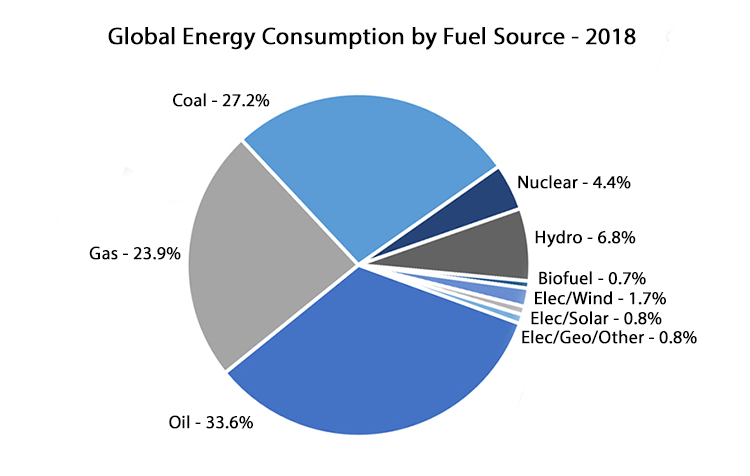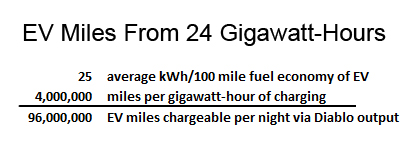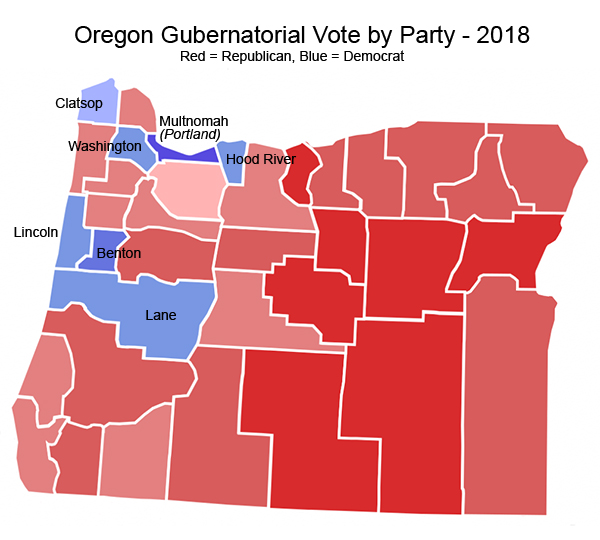The ability for American workers to enjoy middle class lifestyles has been eroding for decades. Conventional explanations abound. American industry in the immediate aftermath of World War II was uniquely unscathed, and with a near monopoly on global manufacturing, was able to pass much of their ample profits on to workers. It wasn’t until the 1970’s that American manufacturers confronted serious foreign competition, and ever since, the competition has just gotten more intense.
By the 1990’s the electronic movement of capital along with trade agreements such as NAFTA turned national labor forces into commodities. And at the same time as American industry was going international, America’s laws were changed to favor mass immigration of unskilled workers who competed for jobs with native workers, driving down wages. These immigrants were also far more dependent on government services compared to previous generations of immigrants, putting stress on government budgets.
Export jobs. Import welfare recipients. No wonder America’s middle class is withering away. But this conventional explanation, however accurate, is only half the story. Yes, for whatever reason, average Americans work harder and earn less today than their predecessors. And the process has been relentless. Every decade since the 1950’s has seen an American workforce making less than they made during the preceding decade. But they are not just making less – things are costing more.
At first glance, this seems counterintuitive. Not everything costs more. Using the consumer price index (CPI) as a yardstick, and adjusting for performance – a modern flat screen television offers far more viewing amenities than a state-of-the-art black and white television circa 1955, yet it costs less in constant dollars. For almost every consumer good, from home appliances to MacDonald’s Happy Meals, that’s true. But it isn’t the cost of appliances and fast food that is breaking family finances today in America, it’s the cost of housing and healthcare. And in these two critical areas, neither of which is adequately reflected in the CPI, the cost-of-living in America has never been higher.
The causes of rising healthcare costs are complex and defy obvious solutions. But the national conversation Americans are having to address the challenge of healthcare is ongoing. This conversation about American healthcare solutions includes expert participants offering all perspectives and reflects diverse ideological roots. While it is impossible to predict whether or not America’s national search for optimal healthcare policies will end well, the dialog is transparent, none of the fundamental issues are being ignored, and nothing is beyond debate.
On the issue of unaffordable housing, however, the opposite is true. Unlike the healthy debate being waged across America on the topic of healthcare, the debate over housing solutions – if one even wants to call it a debate – is decidedly unhealthy. Basic premises go unchallenged. Basic assumptions and options are off the table, considered beyond debate. If the debate over housing policy remains a stunted facsimile of a genuine debate, Americans will not only be condemned to purchase barely affordable housing, but their new housing options will be almost exclusively limited to homes on ever smaller lots – or apartments – in increasingly crowded cities.
The unchallenged premise that lies at the heart of unaffordable housing in America is that there is no room for more suburbs. That single family dwellings on spacious lots are an unsustainable extravagance that must be stopped. That detached homes in new suburbs are unhealthy for people and the planet, and that the only responsible way to build ncerew homes is via “infill” of multi-family dwellings within the footprint of existing urban areas.
This unchallenged premise might be termed “The Density Delusion.” If it hasn’t arrived yet in your state, beware. It’s on its way and no political party – including Republicans – has organized to oppose this agenda. The density delusion now informs public housing policy in nearly every blue state, certainly including the entire Left Coast states of California, Oregon, Washington. As will be discussed, there are other reasons housing is so expensive in these states, but even if all of the other misplaced policies that drive up home prices were reformed overnight, the density delusion, unchecked, would be enough all by itself to render housing unaffordable. It is impossible to restore a reasonable, affordable price equilibrium to housing if all housing development is confined to the footprint of existing cities.
The Density Delusion Relies on the Myth of Vanishing Open Space
A fascinating article published last year by Bloomberg entitled “Here’s How America Uses Its Land” offers several graphics of America’s Lower 48, including the map depicted below. As can be seen, “Cow pasture/range” is by far the most extensive category of land use in the United States.

If you review the source data from the US Dept. of Agriculture as expressed in the pie chart below, it turns out that only 3.7 percent of the Lower 48 states are urbanized. The largest category of land is grassland, at 35 percent, followed by forests at 29 percent. Farmland only consumes 21 percent of land in the Lower 48.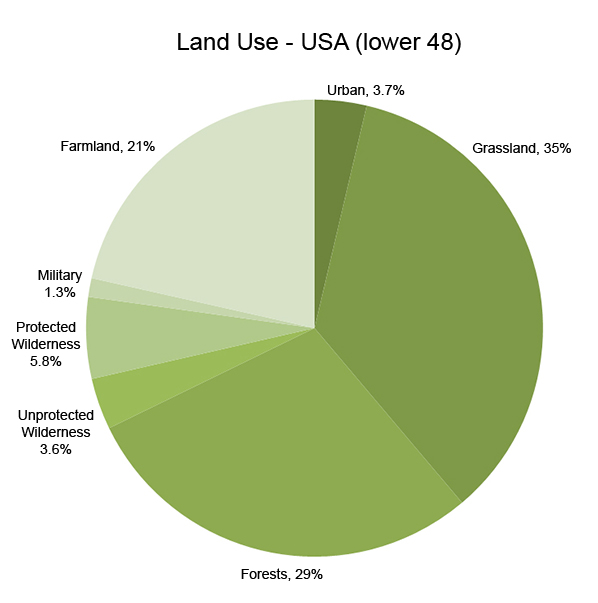
The unasked question that challenges the density delusion should be obvious from these land use facts: Why are Americans unwilling to expand suburbs if grasslands, typically used for cattle ranching, occupy ten times as much space as all of America’s existing cities, suburbs, and industrial areas?
Notwithstanding the fact that there are plenty of private land owners who would voluntarily convert their cattle ranches to housing subdivisions for the right price, overall trends in production and consumption of beef in the United States suggest less land may be required in the future.
According to the U.S. Dept. of Agriculture, the beef cow inventory in the U.S. peaked in 1978 at just over 45 million head, and as of 2018 barely exceeded 30 million, a one-third decline despite the American population increasing nearly 60 percent, from 207 million to 327 million. Corroborating this is another USDA report showing per capita red meat consumption peaking at 150 pounds in 1971, dropping to an estimated 110 pounds in 2019. It is likely that cultural trends favoring healthier food will lead to further reductions in per capita demand for beef in America. Why not build homes on some of that land?
The Epicenter of the Density Delusion, California, Has Abundant Land
If America’s Lower 48 is only 3.7 percent urbanized, which suggests that doubling the national urban footprint would still leave 93.6 percent of the nation unsullied with subdivisions, what about California? How would doubling California’s urban footprint affect the big picture in that state with respect to land use?
A quick look at a map depicting California’s agricultural land shows the vast expanse of irrigated farmland in California’s Central Valley. But surrounding this vital resource is an even larger expanse of “dryland farming and grazing land.” This area, over 40,000 square miles, is not vital to California’s agricultural industry. Also clearly evident on this map is the relatively minute percentage of California’s total land area that is urbanized.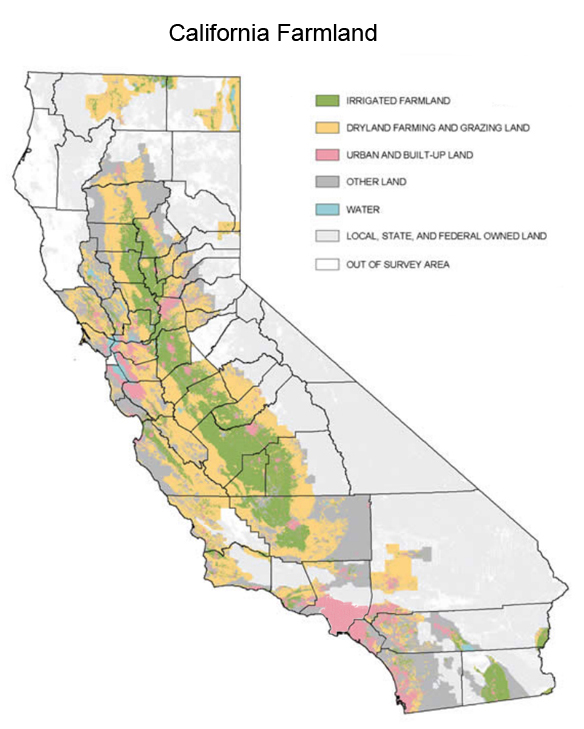
What is clear from viewing the map of California’s farmland is made explicit on the pie chart below. Using data drawn from 2017 USDA data, only 5.3 percent of California’s whopping 164,000 square mile area is given over to residential, commercial, and industrial use. The contrasts are striking. The area consumed by California’s military bases, 6,148 square miles, is comparable to the area of California’s urbanized land, 8,280 square miles. California has 19.7 percent of its land set aside as protected wilderness, 30,661 square miles, nearly four times as much as its entire urban footprint. As for the 25,420 square miles classified as “unprotected wilderness,” this consists primarily of desert and “bare rock,” i.e., the inherently undevelopable granite peaks of the High Sierra. Meanwhile, 42,498 square miles of California is considered “grassland,” with more than half of that given over to cattle ranching and dryland farming. To develop a mere 20 percent of this grassland would allow California’s urban footprint to double.
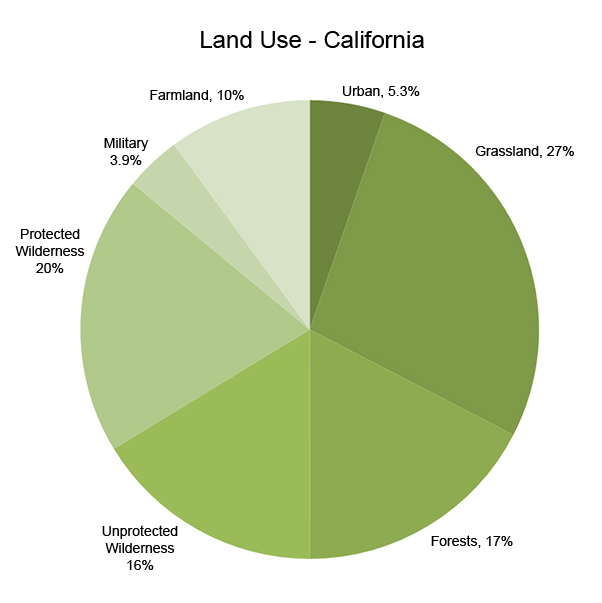
What About the Rest of the World?
If America remains a vast, relatively underpopulated continent, with sizable percentage of arable land, what about other places? What about India, China, Africa? The table below, drawn from UN data and various academic studies, calculates farm resources based on 2050 population estimates for these key regions of the world. As can be seen in the far right column on the first row of data “World,” “pop per m2 farm,” (population per square mile of arable land) it is estimated that in 2050 there will be 10 billion people living on earth, and that for every square mile of farmland worldwide, there will be 833 people. This is an encouraging finding.
Based on population trends already well established in nearly every region on earth (sub Saharan Africa and parts of the Middle East are the only exceptions), global population is already stabilizing. Most experts estimate that by 2050 the global population will have peaked, and 10 billion represents the midrange scenario. While the UN continues to predict an eventual peak of 11 billion by 2100, an increasing number of demographers predict a peak of around 9 billion, with a slow decline beginning as early as 2040. 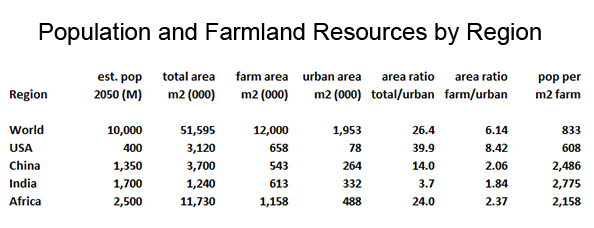
The productive capacity of conventional modern agriculture is to feed roughly one person per acre. While a square mile is only 640 acres, not 833, there are several mitigating factors that clearly predict a future of universal food security. Modern agricultural techniques continue to advance and the commercialized upper end of crop productivity is far higher. In China, for example, year-round polycultures of trees, crops, and aquacultures result in productivity ranging between feeding four people per acre to as high as 20 people per acre.
Worldwide, intensive land based agriculture using modern and traditional techniques offer proven methods to easily feed 10 billion humans on 12 million square miles of farmland, but the future of agriculture may be indoors instead of outdoors. Developments in modern indoor farming promise to not only merely supplement land-based agricultural production, but to displace it altogether by offering food that is cheaper and healthier.
It is possible that using hydroponics, aeroponics, and aquaponics, industrial agriculture operations sited within urban areas can produce enough food to feed the inhabitants, making it unnecessary to import food from farming regions. The high-tech future of agriculture, combined with the stabilization of human population, means there is never going to be a shortage of farmland worldwide, nor will there ever be insufficient space for humans who wish to live in detached homes on spacious private lots.
This point, that there will always be room for suburbs filled with single family dwellings, is underscored by the calculations in column four of the above table, “urban area m2 (000)” (total square miles of urbanized areas). The total urban area worldwide as depicted on this table, 1.9 million square miles (3.8 percent of all land excluding Antarctica), is a hypothetical number. It is based on 10 billion people living in four person households that are each on quarter-acre lots, with an equivalent amount of space allotted for commercial and industrial use. This equates to a population density of 5,210 people per square mile. Actual estimates of worldwide urbanization as of 2018 are only 2.7 percent of global land area excluding Antarctica, and some analysts believe this estimate is grossly overstated.
In reality, major urban centers have far higher population densities. For example, the population density of New York City is 27,000 per square mile. On the opposite coast, San Francisco has a population density of over 18,000 per square mile. On every continent, the population in these urban cores will continue to grow to absorb hundreds of millions of new residents. For most, the decision to live in these dense urban environments will be voluntary, as the amenities of big city life are a compelling allure. But for those who prefer the tranquility of a suburb or a rural environment, that choice should not be rendered unaffordable because of misguided policies. Even worldwide, there is plenty of land.
Debunking the Climate Change Argument Against Suburbs
The most powerful argument fueling the density delusion is the existential boogeyman of climate change. But even if one accepts the fundamental premise of the climate change activists, that human produced “greenhouse gas” constitutes an imminent threat to human civilization and the planet, that does not justify the current policy assault on low density suburbs.
Even the “scientific studies” (of which there are surprisingly few) that are used to attack suburban “sprawl” are themselves riddled with ambiguities. An influential 2014 study coming out of UC Berkeley provides examples. An article produced by UC Berkeley’s media relations department, summarizing the work, writes “A key finding of the UC Berkeley study is that suburbs account for half of all household greenhouse gas emissions, even though they account for less than half the U.S. population.” But data from a 2018 study cited by CityLab claims that 52 percent of Americans live in suburbs. While the measurement criteria used by the UC Berkeley scholars to define who lives in suburbs was obviously different than CityLab’s, it is likely that the “less than half” was only slightly less than half, rendering this “key finding” statistically unimpressive.
The Berkeley study also found that “the primary drivers of carbon footprints are household income, vehicle ownership and home size, all of which are considerably higher in suburbs. Other important factors include population density, the carbon intensity of electricity production, energy prices and weather.” The climate activist take-away form this quote, “all of which are considerably higher in suburbs,” ignores the variability of the other factors cited as causes. Higher income people have bigger homes. That’s true whether this home is an 8,000 square foot penthouse in downtown Los Angeles, or an 8,000 square foot McMansion on a half-acre lot in Palos Verdes. And what about the “carbon intensity of electricity production”?
This points to the biggest fallacy in all studies linking suburbs to excessive belching of “greenhouse gas,” which is this: what if bigger homes and more driving was not linked to higher greenhouse gas emissions? What happens when all cars are gas/electric hybrids that only rely on gasoline for long-range excursions, but handle even lengthy daily commutes relying only on battery power? What happens when electric power is not carbon intensive, thanks to renewables, or nuclear power, or fusion power, or satellite solar power stations, or direct synthesis of transportation fuels from CO2 removed from the atmosphere, or other innovations we can’t yet foresee? Would there still be a concern about suburbanites logging excessive transportation mileage, if vehicles and the fuel they use is harmless even by their standards?
The UC Berkeley study, despite its headline, is filled with these ambiguities. They write: “Surprisingly, population dense suburbs have significantly higher carbon footprints than less dense suburbs, due largely to higher incomes and resulting consumption,” but don’t go on to explain why less dense suburbs aren’t therefore more desirable than suburbs that are densified with infill. Instead, they go on to write “Population dense suburbs also tend to create their own suburbs, which is bad news for the climate.” But why, if the dense suburbs have higher carbon footprints, wouldn’t it be desirable for them to spawn less dense suburbs that have lower carbon footprints?
In the concluding paragraphs of the media summary of the UC Berkeley study, they write “Suburbs are excellent candidates for a combination of solar photovoltaic systems, electric vehicles and energy-efficient technologies.” Ok. So why in the name of climate change mitigation are we expected to ban development of new suburbs, and destroy existing suburbs via densification?
Another authoritative study supposedly linking sprawl to higher greenhouse gas emissions was published in 2008 by a research team at the Harvard Kennedy School’s Taubman School for State and Local Government. Entitled “The Greenness of Cities: Carbon Dioxide Emissions and Urban Development,” according to Google, this study has been cited in 766 “scholarly articles.” In the abstract, the money line goes like this: “Cities generally have significantly lower emissions than suburban areas, and the city-suburb gap is particularly large in older areas, like New York.” The “city-suburb gap.”
For most climate activists, advocates for densification, and activist journalists, that’s as far as they’ll need to read, and they’ll have their source, and they’ll have their link. But if you wade through this 45 page paper, you find what seems to define most scholarly studies on the “city-suburb gap,” namely, an unmanageable degree of complexity that is coped with by adopting an unacceptable degree of subjective assumptions and over-simplifications, which are then crammed into impenetrable equations.
While the authors of this study are clearly making a diligent attempt to determine what variables define the per capita “carbon footprint” of low density suburbs vs high density cities, their very transparency in explaining their methodology calls their methodology into question. Example: “For a standardized household, we predict this household’s residential emissions and emissions from transportation use. We look at emissions associated with gasoline consumption, public transportation, home heating (fuel oil and natural gas) and electricity usage. We use data from the 2001 National Household Travel Survey to measure gasoline consumption. We use year 2000 household level data from the Census of Population and Housing to measure household electricity, natural gas and fuel oil consumption. To aggregate gasoline, fuel oil and natural gas into a single carbon dioxide emissions index, we use conversion factors. To determine the carbon dioxide impact of electricity consumption in different major cities, we use regional average power plant emissions factors, which reflect the fact that some regions’ power is generated by dirtier fuels such as coal while other regions rely more on renewable energy sources. We distinguish between the emissions of an area’s average house and the emissions of a marginal house by looking particularly at homes built in the last twenty years.”
Good luck with that.
For the skeptic, an unanticipated value of the Harvard study is the insight it provides into what is a burgeoning new field of bureaucratic skimming, namely, carbon accounting. For those readers with a background in accounting, maybe even tax accounting or government accounting, try this on for size, from page 8, “Unlike the place-specific energy tax, the zoning tax does not impact energy use directly, but it does reduce the number of people in location one. Specifically: “aN1/aZ1 = -1/[1/Qb1 x k” (N1/Qb1) + 1/Qb2 x k” (N2/Qb2) – 1/Qf1 x f” (N1/Qf1) – 1/Qf2 f” (N2/Qf2)] > 0,” and then, “The overall impact of zoning on social welfare is (E2 – E1)(NC'(NE) – t) +Z1)aN/oz, which is positive as long as (E1 – E2)(NC'(NE)-t) > Z1.”
Got that? Of course not. And now you know why consulting firms are billing government agencies countless millions of dollars to come up with “science based” policies for carbon mitigation. Full employment for PhDs.
It is interesting to highlight just how dispassionate the Harvard researchers are when it comes to the impact their theories may have on real people. Consider this excerpt: “One natural concern with our approach is that households in areas that spend more on energy have less income to spend on other things that also involve greenhouse gas emissions. If people in Texas are spending a lot on air conditioning and gas at the pump, then perhaps they are spending less on other things that are equally environmentally harmful. We cannot fully address this concern, since it would require a complete energy accounting for every form of consumption, but we do not believe our omissions fatally compromise our empirical exercise.”
Note how in the preceding excerpt the researchers acknowledged that “households in areas that spend more on energy have less income to spend on other things,” but rather than admit that perhaps that could mean that carbon taxes, i.e., punitively priced energy, are regressive and harm low and middle income families, the researchers sped quickly onward to observe that “then perhaps they are spending less on other things that are equally environmentally harmful.” The risk here? Not that artificially high energy costs might cause hardship. Only that the money these hypothetical consumers wasted on overpriced gasoline might have been paying for other equally “carbon intensive” activities. Such analytical uncertainty! The paragraph concludes by suggesting that only a “complete energy accounting for every form of consumption” would enable a proper analysis of this risk. Bring on the funding. Hire more consultants.
In the light of day, the analytical tools that are used to justify urban densification may be similar in some ways to the computer models developed to perform global climate simulations. They are attempting to reduce extreme complexity to a set of equations and variables that guarantee a desired conclusion. And with respect to the studies that are used to justify densification, there are common sense rebuttals to the conclusion that densification results in lower greenhouse gas emissions:
- Cars of the future will not emit greenhouse gas.
- Energy sources in the future will not emit greenhouse gas.
- Upgraded freeways and smart cars will eliminate or greatly reduce traffic congestion.
- Smart cars, share cars, and drones will reduce the percentage of impermeable heat conducting surfaces (roads and parking lots).
- Single family dwellings use far less per unit energy in construction than high rise apartments.
- Low density suburbs have more (and larger) trees and other greenery per capita.
- Employers and jobs will migrate, creating new jobs close to new homes.
- Low density suburbs have a lower per capita “heat island” effect.
- Increasing percentages of wage earners will telecommute.
If and when a reputable, unbiased study is released that takes these variables into account, the conclusion will likely refute the conventional wisdom. Low density suburbs do not increase greenhouse gas. Nor, for that matter, do they consume an unsustainable amount of open land.
An article published last year in Planetizen reviews the book “The Urban Fix: Resilient Cities in the War against Climate Change, Heat Islands and Overpopulation,” by Doug Kelbaugh. The title of this book review – and how many people only read the titles? – is “The Problems With Suburbs Are Numerous. Is a Change of Course Possible?” But consider this excerpt from Kelbaugh’s book that was generously included in the review:
“Drone deliveries, ride-sharing, car-sharing, AVs that park themselves and connect to house lights and thermostats will be commonplace, as will up to a 50 percent reduction in paved area. Less hardscape won’t be difficult, given the absurdly wide streets in contemporary subdivisions.” Kelbaugh is not making a case here to abandon low density. If streets and parking lots are too expansive and too hot, then allow the revolution in smart cars, share cars, and drones to facilitate narrower streets and smaller parking lots. If homes in the suburbs are “soulless,” as Kelbaugh alleges, then build homes with soul.
The Hidden Agenda That Fuels the Density Delusion
If the only political force pushing the density delusion were misanthropic or misguided environmentalist nonprofits and their army of plaintiff attorneys, the consequent Left Coast policies of “infill,” “smart growth,” and “urban containment” would roll east against the Sierra Nevada and Cascade mountain ranges and fall back onto the Pacific Coast. But the environmentalist lobby, while formidable, is not formidable enough on its own to cram Americans into overpriced apartments and unaffordable homes on nonexistent lots. The density delusion is promoted by a powerful assortment of special interests.
It doesn’t require a degree in economics to understand the hidden agenda behind the density delusion, one merely needs to understand the law of supply and demand. When the supply of housing is artificially constrained by putting a wall around every existing urban area, and prohibiting or severely restricting any construction outside the wall, the price of homes inside the wall go up. This is especially true if the population in these regions is increasing, which increases the demand for homes.
Between 1980, when the pioneering concept of enforcing “greenbelts” began to find expression in actual zoning policies, and 2018, the population of California went from 23.7 million to an estimated 40 million. Oregon, from 2.6 million to 4.2 million. Washington, from 4.1 million to 7.7 million. To be sure, urban containment wasn’t well established in these states until recent years, but today the density delusion informs policy in every state capital and every major city on the Left Coast. Demand increases constantly, supply is restricted and cannot keep up.
California has passed dozens of laws discouraging development. Notable among them are Sustainable Communities and Climate Protection Act, passed in 2008, which has made it nearly impossible to build housing outside the “urban service boundary.” Two other significant environmentalist laws are the landmark 1970 California Environmental Quality Act, and the precedent setting Global Warming Solutions Act of 2006, along with numerous others at the state and local level. These laws make it nearly impossible for Californians to build affordable homes, develop energy, or construct reservoirs, aqueducts, desalination plants, nuclear power plants, pipelines, freeways, or any other essential enabling infrastructure.
Oregon and Washington are not far behind California. According to a 2015 report in the City Lab, Seattle has been fighting “sprawl” for over 20 years. The goal, to channel growth into “urban villages.” These are high density, mixed use developments (known as “transit villages” in California) sited along light rail or bus routes. The impact of Seattle’s experiment in densification and urban containment on real estate prices is unambiguous. The median home price in the entire Seattle-Tacoma-Bellevue Metro region is $490,300, compared to the U.S. median of $226,000.
Oregon’s state legislature, late to the party but determined to outdo the competition, just passed House Bill 2001, which would “eliminate single-family zoning around the state. In cities with more than 25,000 residents, duplexes, triplexes, fourplexes, and ‘cottage clusters’ would be allowed on parcels that are currently reserved for single-family houses; in cities of least 10,000, duplexes would be allowed in single-family zones.” Democratic Governor Kate Brown is expected to sign this legislation. The median price of a home in Portland is already $419,700. It shall be interesting to see how this new law will affect the price of a single family home.
What California, Oregon, and Washington policymakers are doing is driving up the cost of single family detached homes by discouraging, if not outright prohibiting, construction of homes outside the existing urban boundaries. The median price of a home in Los Angeles is $686,700; in San Jose, an astronomical $1,022,300. In Oregon’s case, the supply of detached homes may actually decrease, as existing homes are demolished to make way for apartments. But what happens when more people are forced to live within the boundaries of existing cities, and, unless they want to migrate to a red state, forced to pay prices far beyond what would apply in a normal market? Who benefits?
When politically contrived artificial scarcity is imposed on a market, an asset bubble is formed. As long as the scarcity can be maintained, the bubble will expand. The beneficiaries of a real estate bubble are public entities, which not only collect property taxes from more assessed properties, thanks to densification, but also collect based on higher assessments, thanks to the inflated values. Public sector pension funds also benefit, because their real estate portfolios benefit from the asset appreciation. But the imposition of artificial scarcity is not confined to housing. And to understand the strategic value of artificial scarcity to the American oligarchy, it is necessary to explain what made this squeeze on ordinary Americans not only incredibly profitable, but necessary.
The Financialization of the American Economy
The ongoing destruction of America’s middle class began with the financialization of the American economy, a process that began in the 1970s. Greta Krippner, an economic sociologist at the University of Michigan, defines financialization as “a pattern of accumulation in which profit making occurs increasingly through financial channels rather than through trade and commodity production.”
Financialization is a threat that has no ideology. The left tends to blame economic challenges on the excessive power, influence, and greed of oligarchs. The libertarian right tends to blame economic challenges on excessive regulations emanating from oversized government. But they’re both right. Financialization has further empowered the oligarchs who have turned the American worker into a commodity. And financialization is the toxic remedy that has, for a time, enabled oversized government.
An excellent in-depth article in Time Magazine published in 2016, entitled “American Capitalism’s Great Crisis,” quotes Krippner’s deeper explanation of how financialization began:
“The changes were driven by the fact that in the 1970s, the growth that America had enjoyed following World War II began to slow. Rather than make tough decisions about how to bolster it, politicians decided to pass that responsibility to the financial markets. The Carter-era deregulation of interest rates—something that was, in an echo of today’s overlapping left-and right-wing populism, supported by an assortment of odd political bedfellows from Ralph Nader to Walter Wriston, then head of Citibank—opened the door to a spate of financial “innovations” and a shift in bank function from lending to trading. Reaganomics famously led to a number of other economic policies that favored Wall Street. Clinton-era deregulation, which seemed a path out of the economic doldrums of the late 1980s, continued the trend. Loose monetary policy from the Alan Greenspan era onward created an environment in which easy money papered over underlying problems in the economy, so much so that it is now chronically dependent on near-zero interest rates to keep from falling back into recession.”
Carter. Reagan. Clinton. It’s important to document the bipartisan emergence of financialization. It can’t be unwound, or even discussed accurately, simply by referring to conventional ideological schisms. The impact of financialization in America has been to enable private households and government agencies to spend more than they take in, and to make up the difference by borrowing more than they can ever hope to pay back. And through it all, for the past 40+ years, the financial sector has extended the credit, accumulating more power and profit every step of the way. Ideology and partisanship provided the justifications and the means, but they came from the right and the left.
Estimates vary as to how much corporate profit now accrues to the financial sector in the U.S., but range between 25% and 40%. By comparison, in Germany the financial sector earns about 6% of corporate profits. America’s overbuilt financial sector attracts the brightest college graduates. Math majors who might have gone into applied physics, engineering, chemistry, now migrate to Manhattan and work for the hedge funds.
Closer to home, here’s how financialization has harmed ordinary Americans:
- Created an incentive through low interest rates and tax law for people to borrow instead of save,
- Rendered housing and college tuition unaffordable, thanks to low interest rates inducing borrowers to bid up prices,
- Destroyed the ability of thrifty households to save, because only risky investments offer adequate returns,
- The emphasis on shareholder value above all else has depressed wages and driven jobs overseas,
- Attracted brilliant innovators to work for financial firms (which produce nothing) instead of actual industries that create jobs and national wealth.
There’s more – and this is the least discussed but perhaps the most significant consequence of financialization. It expands the public sector, and it helps public sector unions. Here’s how:
- Governments can expand beyond the capacity of their tax revenues by borrowing at low interest rates,
- Government unions can negotiate over-market pay and benefits, relying on borrowing to cover deficits,
- Government pension funds can make risky investments with the taxpayers backing them up,
- As financialization drives middle class citizens into poverty, the government expands its aid programs.
The connection between government unions and the financial oligarchs who currently run both political party establishments may be abstruse, but it isn’t trivial. They have a common interest in a financialized economy; a common interest in seeing what is now the biggest credit bubble – as a percent of GDP – in American history get even bigger. This is explicitly contrary to the interests of ordinary Americans. The awakening grassroots resistance to the financialization of America explains the sharp rise of populism starting in 2016, and it’s just begun.
The Scarcity Profiteers
Where there is credit, there is collateral. When consumers borrow, home equity is the collateral. And if America’s 30+ year borrowing binge is to continue uninterrupted, collateral values need to climb. Restricting new housing construction to infill causes the value of all real estate within the approved zones to soar. Investors get rich. Speculators get rich. Meanwhile, ordinary homeowners, caught in a spiral of debt accumulation because they spend more than they make, sink further into financial servitude. But as their property values climb, they borrow more, they spend more, and America’s financialized economy keeps spinning. If and when this unsustainable debt binge hits the wall, America’s oligarchs will have taken all the money off the table. They are a macroscopic version of the Romneyesque private equity sharks – raid a company and acquire a controlling interest, load it up with debt, collect bonuses, declare bankruptcy, sell the assets, walk away.
A similar profiteering opportunism underscores the renewables mania. Not only do high tech companies capitalize on fantastic opportunities to sell gadgets to create a panopticon of energy surveillance ala the “internet of things,” where every home appliance is wired and monitored by the utilities. At the same time the highly regulated public utilities are offered spectacular new avenues for higher profits, because while their profit percentages are fixed, and the units of energy they can generate are fixed, when they sell expensive renewable energy to the consumer instead of inexpensive natural gas or nuclear power, they can still double their revenues and profits.
The scarcity profiteers operate not in collusion or conspiracy, but merely as a collection of special interests whose special interests all converge on the same goal: make water, energy, transportation and housing as expensive as possible. Increase regulations and unleash an avalanche of lawsuits so only the biggest, most resilient corporations survive, and emerging competitors are crushed.
In California’s, and increasingly in other states, a punitively high cost of living is the result of conscious political choices, and the primary force behind these choices is not desire to protect the environment, it is greed. The people who profit by artificial, contrived scarcity, don’t want anything to change. They are the utility companies, the trial lawyers, the Silicon Valley “green” entrepreneurs, and billionaires who already own the artificially limited supplies of land and housing.
If “carbon emissions auctions” trading ever takes hold nationally, it will launch the biggest skim operation in the history of the world. Every molecule of carbon embodied in every joule of energy will be accounted for, using a preposterous, byzantine, corruptible if not fraudulent financial alchemy. These carbon units will be tracked, so that rights to emit them can be traded on an exchange, where the bookies of Wall Street will get a cut. All of this will be implemented and operated at stupefying expense. Trillions of dollars in annual transactions will have to pass through this gauntlett.
Ending the Density Delusion – Restoring Sanity to Housing Markets
Well intentioned but misguided policies to make housing affordable include rent control, which would just take away the incentives to maintain properties or invest in new income property. Another misguided solution is to offer government subsidies, which leads to accepting overpriced construction bids from the favored contractors without solving the underlying problems of punitive fees and unacceptable delays in permitting. But the most misguided policy of all is mandating densification instead of making it easier to build entire new cities on open land.
The density delusion exemplifies the power of a good value, environmentalism, taken too far and causing more harm than good. Defenders of densification dismiss the concerns of community groups that don’t want to see their neighborhoods destroyed. But it isn’t the wealthiest neighborhoods where densification policies will result in rent subsidized fourplexes dropped onto a lot on a street otherwise filled with single family dwellings. Residents of wealthy neighborhoods will hire attorneys and stop projects like that, driving the investors and developers into the middle class and lower middle class neighborhoods, where hiring an attorney to fight city hall is not an option.
Which brings up the ultimate issue surrounding densification, artificial scarcity, and a politically contrived high cost of living. It is not protecting the environment to engage in these policies. It is class warfare prosecuted by the rich against the poor. It is the unifying populist issue of our time, currently overshadowed by identity politics as a useful and very divisive distraction. But the fixation of America’s electorate on identity politics is precariously maintained. The reality in American politics is this: identity politics is a distraction from, and extreme environmentalism is a false justification for, a massive transfer of wealth from the have nots to the haves.
America’s elites, to the extent they wish to invite hundreds of millions of unskilled immigrants from all over the world to move to this nation at the same time as they insist that everyone – native born and new arrivals alike – stack themselves into existing urban areas, are betraying their fellow citizens. They are creating scarcity ostensibly to save the planet, but in reality this scarcity creates asset bubbles that collateralize an economy running on debt accumulation.
Restoring sanity to housing markets will require wrenching economic policy adjustments. Public sector reform, pension reform in particular, combined with sweeping reform of overreaching environmentalist regulations, will allow public money to be redirected into enabling infrastructure: energy, water, transportation. Eliminating or rolling back additional excessive environmental regulations, along with streamlining the permitting process and slashing building fees, will enable private developers to construct entire new cities on open land served by new infrastructure, dramatically lowering the price of housing everywhere.
One huge upside to these dramatic reforms is restoring the potential for leapfrog technologies to be funded, researched, and brought to market. With these changes, Americans will have a future where affordable abundance is the result of competitive development of housing and infrastructure, and financial surpluses are used to build hyperlanes instead of pay pension funds, to build next generation nuclear power plants instead of purchase carbon emission credits, and for homeowners, to be able to afford to take a vacation on the moon, because their mortgage payment was manageable.
This article originally appeared on the website American Greatness.
* * *
Edward Ring is a contributing editor and senior fellow with the California Policy Center, which he co-founded in 2013 and served as its first president. He is also a senior fellow with the Center for American Greatness, and a regular contributor to the California Globe. His work has appeared in the Los Angeles Times, the Wall Street Journal, the Economist, Forbes, and other media outlets.
To help support more content and policy analysis like this, please click here.



